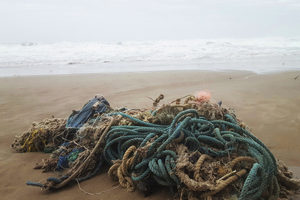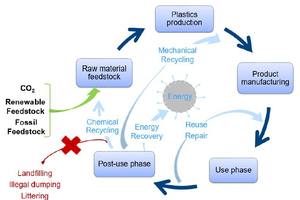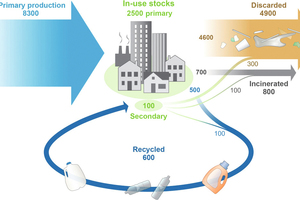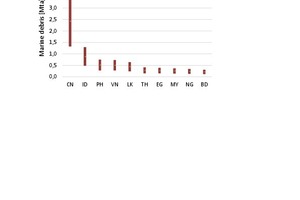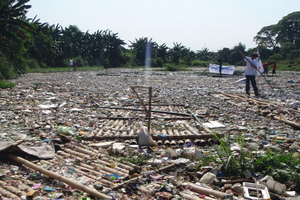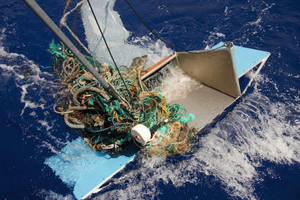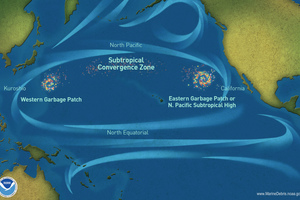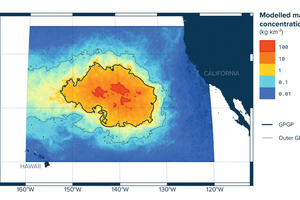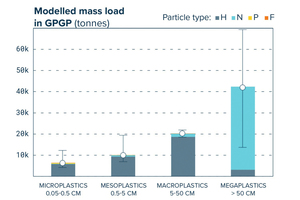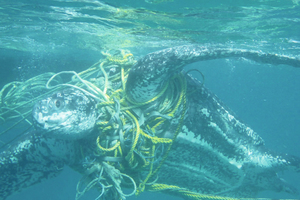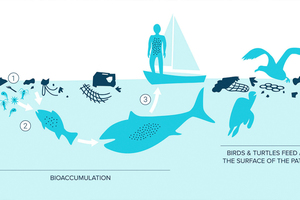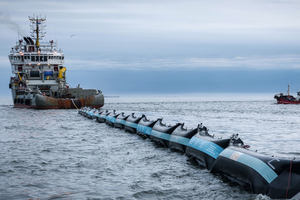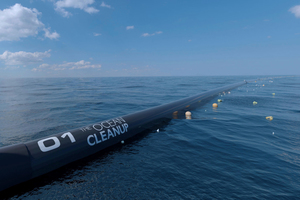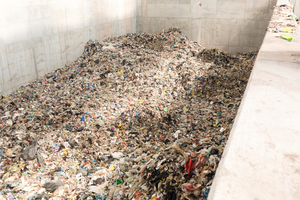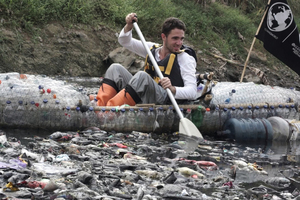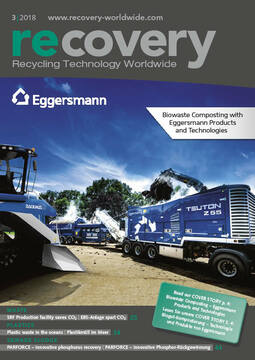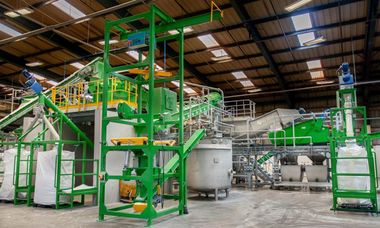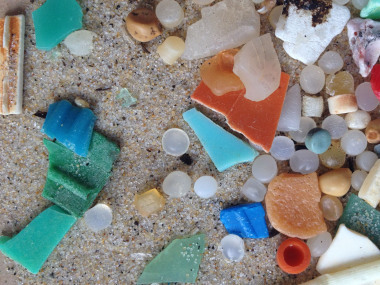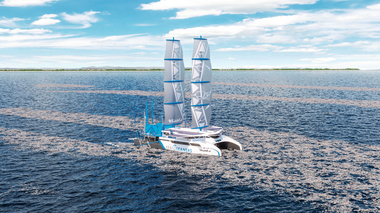Plastic waste in the oceans – consequences and strategy solutions
What had long been considered a trivial offense has meanwhile become a very serious problem: Allowing plastic waste to enter the oceans. The following overview provides data and facts and informs about the negative environmental consequences and impacts while at the same time presenting possible solutions.
1 Introduction
Plastics are indispensable in our daily lives, as they have an extremely wide variety of applications and are usually very cheap to produce. Especially in the case of packaging, the weight advantages of plastic are unbeatable. However, most plastic articles only have a short life span. Beverage bottles, plastic bags and various other products often end up in the garbage bin or landfill site after only a single use. To enable recycling of the materials, complex procedures are required (Fig. 1) [1]. Alternatively, the materials can be thermally utilized as a substitute fuel. The time required by non-utilized plastic waste to break down varies from less than a year (bioplastics) to several hundred years (PET bottles). This is why waste plastics littered or dumped into the environment and polluting the oceans are meanwhile to be found practically everywhere in the world.
Global demand for plastics has increased from 2 million tonnes in 1950 to about 350 million tonnes (Mta) in 2017. It is expected that the amount of plastic produced will double in the next 20 to 25 years, even though the resources of raw material – crude oil – are dwindling. By 2015, around 8300 Mta of plastics were produced (Fig. 2), of which 600 Mta were recycled or shipped to other countries for recycling, 800 Mta were burned or used for energy generation, and 4900 Mta were sent to landfill sites or ended up as litter in the environment and the oceans. Only 10 % of the recycled quantities were reused more than once. By 2015, a total of 5800 Mta of plastic waste had been produced. If production continues to rise, the amount of waste will increase to 26 000 Mta by 2050 [2].
2 Input of plastic waste into the oceans
There are only rough estimates for the global amount of plastic waste entering the oceans, since of course no relevant statistical data are collected. The first estimates of the quantities involved date back to the scientific literature of the early 1970s. In 2015, a group of authors [3] published data relating to 192 coastal countries, which are based on the population of these countries in a coastal strip 50 km in width and the practice of waste treatment in these countries. According to this study, out of 275 Mta of plastic waste produced worldwide in 2010, 4.8 – 12.7 Mta (or 1.7 – 4.6 %) entered the oceans from land-based sources. In the popular scientific literature, it is generally accepted that 8 Mta of plastic waste migrates annually into the oceans.
Fig. 3 shows the ten largest plastic waste polluters of the oceans in the view of the authors [3]. Lower and upper quantity limits were determined for each country. China is found responsible for 1.32 – 3.53 Mta. Indonesia and the Philippines follow in second and third place with 0.48 – 1.29 and 0.28 – 0.75 Mta, respectively, closely followed by Vietnam. Overall, it is striking that countries in Asia, and in particular in Southeast Asia, are responsible for a large proportion of the pollution of the oceans with plastic waste. In the TOP 10 countries that account for 69 % of marine pollution with plastic waste, Egypt and Nigeria are the only non-Asian countries. The TOP 20 polluters, which include South Africa, India, Pakistan, Turkey, Brazil, North Korea and the US, accounts for 89 % of the plastic waste input. The EU-28 would be listed in the polluters „ranking“ in 18th place with 0.05 – 0.012 Mta.
The amount of plastic waste that is „disposed of“ improperly and in an unregulated manner amounts to about 31.9 Mta and is the primary source of the marine pollution. Plastic waste is generally swept into the sea via the rivers. Other sources are landfills and illegal garbage dumps in river deltas, swamps or on sea shores. According to calculations by German hydrologists, more than 80 % of the plastic waste originates from ten rivers, eight of which are in Asia and two in Africa. The problem rivers include the Marilao (Fig. 4) in the Philippines, the Citarum in Indonesia, the Mekong and Pearl rivers in Vietnam/China, the Yangtze and Yellow rivers in China, the Ganges in India and the Indus in Pakistan. In Africa, the Nile (Egypt) and the Niger (Nigeria) are the main culprits.
In addition to the plastic waste entering the oceans from land-based sources, marine pollution is increased by the garbage disposal of ships on the high seas, as well as broken, abandoned and lost fishing nets and ropes (Fig. 5). Their amount is estimated by various sources to be 10 – 20 % of the overall plastic waste pollution of the oceans. A not insignificant contribution is also made by cargo losses and illegal dumping of garbage into the oceans, which was prohibited and criminalized as early as 1988 by the International Maritime Pollution Prevention Convention (MARPOL). Instead of taking their garbage to harbours for proper disposal, many a ship‘s crew simply throws it overboard. This has to do with profit maximization, corruption and plain stupidity, negligence and lack of environmental awareness, vices which are shared by almost all countries and cultures.
3 Extent of the marine pollution
Today, it is estimated that about 150 million tonnes of plastic waste already pollute the oceans. Much of the garbage drifts on the surface of the water and is accumulated by ocean currents. The greater portion of this, estimated to be up to 70 %, eventually sinks to the sea floor due to algae growth and other causes, and only reappears on beaches if carried there by ocean currents and the action of high waves. The plastic garbage to be found along the coasts and in harbours is only the visible tip of the iceberg. Beaches of many uninhabited islands have literally disappeared under piles of garbage. Large islands of plastic garbage have been formed by gyres (circular ocean currents) in the North Pacific (Fig. 6), the Northern Atlantic, and most recently in the Barents Sea north of Murmansk. Of these, the Great Pacific Garbage Patch (GPGP) between Hawaii and California has recently become the subject of the greatest attention.
According to recent studies [4] by the Dutch foundation „The Ocean Cleanup (TOC)“ in 2015, the GPGP is 4 to 16 times larger than previously assumed and has an area of 1.6 million km2 (Fig. 7) , which is five times the size of France. Surveys carried out by a number of ships and by plane concluded that there was a quantity of approx. 80 000 t of plastic waste in the centre of this gigantic concentration of drifting plastic waste. If the fringe areas are included, the mass is well over 100 000 t. The majority of the plastic items are larger than 5 cm (macroplastics measuring 5 – 50 cm and megaplastik with dimensions over 50 cm). Fishing nets and other items disposed of from ships account for almost ¼ of the garbage (Fig. 8). Microplastics (0.05 – 0.5 cm) account for almost 95 % of the plastic particles, but only make up about 8 % of the total mass. An important finding of the surveys is that the amount of plastic waste in the GPGP is obviously increasing rapidly.
So-called microplastics represent a particular hazard. In other definitions the term microplastic includes all plastic particles smaller than 5 mm. Microplastic is created by the embrittlement and disintegration of larger plastic items and by the action of light and the release of plasticisers from the plastics. Other sources include the abrasion of car tyres, the microplastic particles used in cosmetics and fibres from synthetic garments. For example per wash cycle, up to 1900 tiny plastic particles were found in the water pumped out of washing machines. In a study published in 2018 [5] concerning the degree of pollution of Arctic ice, large amounts of microparticles per liter were found in ice samples dating from 2014 and 2015. Very large amounts of microparticles have also been found in water samples from the North and Baltic Seas.
4 Negative environmental impacts and consequences
The global costs associated with plastic waste are estimated to be around US$ 8 billion [6]. This includes an estimation of the impact on individual consumer segments and, for example, the cost of cleaning beaches and coastal strips. Consequential costs such as touristic losses due to littered beaches or the repair of ship propellers damaged by ropes or so-called ghost nets are not included. Nor does the study quantify the consequences for human health, ecosystems or animal mortality. The stomach content of dead fulmars is now recognized as valid evidence of pollution of the oceans with plastic. Fulmars are ocean-going birds that obtain their food from the open ocean, where they spend most of their lifetime.
More and more plastic items are being found in the stomachs of dead sea birds. They suffer fatal intestinal obstruction or starve to death despite having a full stomach. Researchers assume that in the future almost all seabirds will have plastic items in their stomachs. In addition to seabirds, plastic pollution of the oceans is particularly affecting the health of marine mammals, fish and turtles. For example, the leatherback turtles, which mainly feed on jellyfish, frequently confuse floating plastic bags with their food. Often, the animals also get ensnared in drifting nets (Fig. 9) and often suffer a painful death. Plastic waste is also found in the stomachs of stranded whales. At the beginning of 2016, a sperm whale stranded on the shore of the German Wadden Sea had sections of fishing net in its stomach.
The UNEP [6] assumes that 331 species of bird and animal ingest plastic waste from the sea as food. Other sources even assume significantly larger numbers. One of the biggest problems is bioaccumulation or progressive accumulation up the food chain (Fig. 10). Microplastic is even ingested by plankton (the smallest marine organisms). In addition, because of their specific high surface area, microplastic particles accumulate toxins such as polycyclic aromatic hydrocarbons, originating e.g. from oil residues. In fact, such plastic particles contain 3 to 4 times as much toxins as the „normal“ seabed. Plankton, krill, small crustaceans, algae and the like are eaten by smaller fish and in turn the smaller fish are eaten by predatory fish. Finally, the plastic ends up in the food of human beings. Plastic waste also endangers sensitive ecosystems such as coral reefs and mangroves.
5 Countermeasures and approaches to solving the problem
In December 2017, the United Nations Environment Assembly (UNEA/EA.3/L.20) passed a resolution in Nairobi calling on all countries to help rid the oceans of plastic and make changes to their waste disposal behavior. The aim is to end the production of disposable plastic and to remove plastic waste from the oceans. One approach to achieving this objective is investment in improved collection and treatment of municipal waste, especially in third world countries. 200 countries have signed the Nairobi resolution to remove plastic waste from the oceans. Regrettably, the United States, China and India have refused to sign the UN resolution. However, the World Plastics Council, the association of plastic manufacturers, has endorsed the resolution.
Great Britain intends to set a good example and completely ban the use of disposable plastic articles from 2019 onwards. McDonalds has already responded by withdrawing plastic straws from circulation. However, experts regard such actions as rather ineffective. What would really help on a global scale is to stop uncontrolled waste disposal, especially in developing countries, and to establish functioning structures for the collection and processing of waste. International development agencies have been working towards this end for decades. International donor organizations have already collected billions of US dollars, but most of the time the money either seeps away or is not used effectively enough.
A counter-example is the concept of The Ocean Cleanup (TOC). This technology company was founded in 2013 by 18-year-old Dutch student Boyan Slat. The aim of this project is to collect and recycle millions of tons of plastic waste, such as that present in the GPGP, from the oceans. The technology based on multiple platforms connected to tubular pontoons floating on the surface of the ocean (Fig. 11 and Fig. 12) is currently being tested. The collection technology makes use of the natural ocean currents. It would take about 5 years to clean up 50 % of a large ocean gyre. It is planned to start the Pacific Cleanup in 2018. Up to mid 2017, the company had raised more than US$ 30 million in project funding and research donations.
A large number of other possible solutions has been worked out. The „Marine Litters Solution“ organization, an association of 74 plastics associations from 40 different countries, currently has 355 partnerships and projects underway, planned or completed [7]. These range from public relations campaigns to large-scale beach cleaning events. The International Solid Waste Association (ISWA), produced a report called „Global Waste Management Outlook“ (GWMO) in collaboration with the UNEP, proposing a number of meaningful measures [8], which are mainly oriented towards proper waste management, entailing the proper collection and subsequent treatment of municipal waste.
Solutions for processing waste into alternative fuels (Fig. 13) in power plants, cement factories or the like have long been implemented [9]. In some countries, such as Sweden, municipal waste has already disappeared from the market.
6 Personal concern
Environmental protection organizations such as Greenpeace or the World Wildlife Fund (WWF) have focussed strongly on this topic for a long time and have achieved a great deal through public relations campaigns, events, direct contact with policy makers and discussions with representatives of professional associations. A high level of concern in the population was recently generated by the movie „The Blue Planet“. In the UK, where the series was produced by the BBC under the title Blue Planet II and was televised in 2017, the documentary was the most successful TV show of the year: 14.1 million people saw the first episode. The elaborate series, filmed on 125 expeditions on every continent and in every ocean, has been broadcast in 30 countries. In Blue Planet II, the famous animal filmmaker and naturalist Sir David Attenborough acts as moderator and off-speaker.
In social networks, plastic pollution of the oceans and beaches has become a major topic. Unfortunately, very many people all too quickly conclude that they can help with a personal contribution, e.g. no longer using plastic straws. This may give them a good conscience, but is absolutely negligible when it comes to combatting the overall plastic waste problem. Likewise, although actions like buying US$ 20 bracelets to finance the cleanup of 1 pound or 0.45 kg of plastic waste on beaches or in oceans are a well-intentioned thing, it would probably have a greater effect if everyone would take 2 or 3 minutes to collect plastic litter on every walk along the beach. Of course, it helps if people avoid using plastic or switch to alternative materials in their everyday lives, but in our modern society this easily finds its limits when it comes to product packaging.
In 2017, Gary and Sam Bencheghib, two environmental activists and founders of „Make a Change World“, built kayaks out of plastic bottles and paddled along the Citarum in Indonesia, considered one of the most polluted rivers in the world (Fig. 14). In 2009, the ADB (Asian Development Bank) had already provided a sum of US$ 500 million to clean the river, but only US$ 42 million had actually been spent. With their action, the two brothers wanted to draw attention to the dire situation of the Citarum and to the ineffective previous efforts to clean up the river. The Citarum is about 270 km long, is lined by numerous textile factories, feeds 3 hydropower plants, irrigates 400 000 hectares of rice fields and enters the sea near Indonesia‘s capital Jakarta. Every day, the Citarum transports about 280 tons of waste into the sea.
In their two-week campaign, the two environmental activists canoed along 68 km of the river. The documentary was made available to the Indonesian government and impressed Prime Minister Joko Widodo so much that he ordered the river to be cleaned up by 2025. 5000 soldiers were delegated to tackle the task. The plan is to return the river to drinking water quality for the nearly 30 million local residents. The action is a good example of what personal concern can do. And those who think it‘s enough to voluntarily stop using plastic straws or buy a bracelet should perhaps reconsider their attitude to the subject.
7 Outlook
Reducing or eliminating plastic waste from the oceans first and foremost requires improved concepts and methods for collecting and recycling waste in Third World countries. The financing of such projects could be provided by the developed countries, which would also provide the bulk of the technology. The European plastics industry employs 1.5 million people in some 60 000 companies and generates € 350 billion in annual sales [10]. A tax of only 2 % on plastic items would generate € 7 billion of annual revenue, which would be sufficient to finance all global projects and achieve plastic-free oceans. The same applies to the US, meaning that sufficient funding would be available if people really wanted this to happen.

